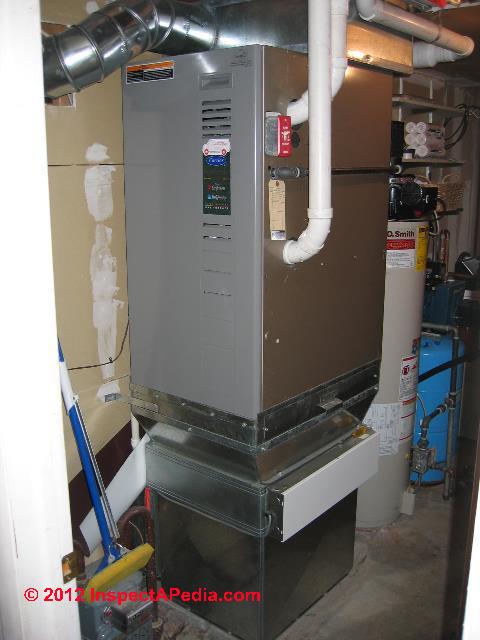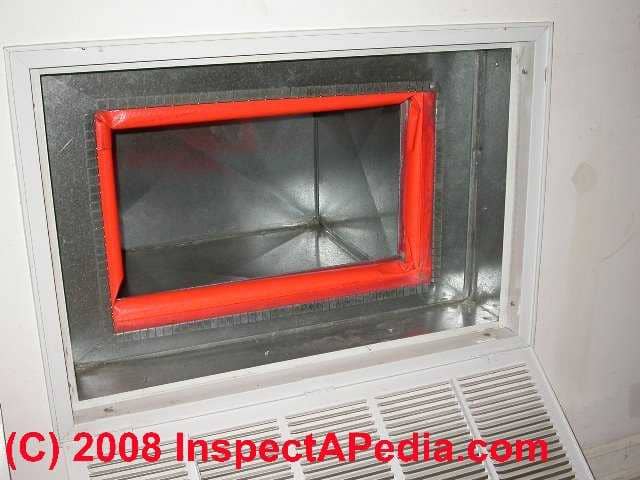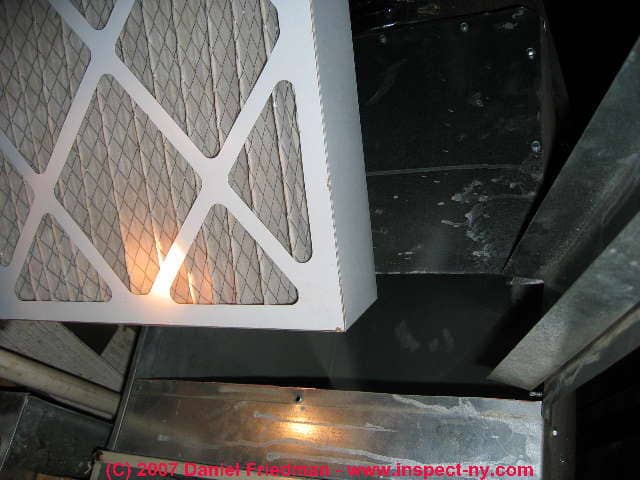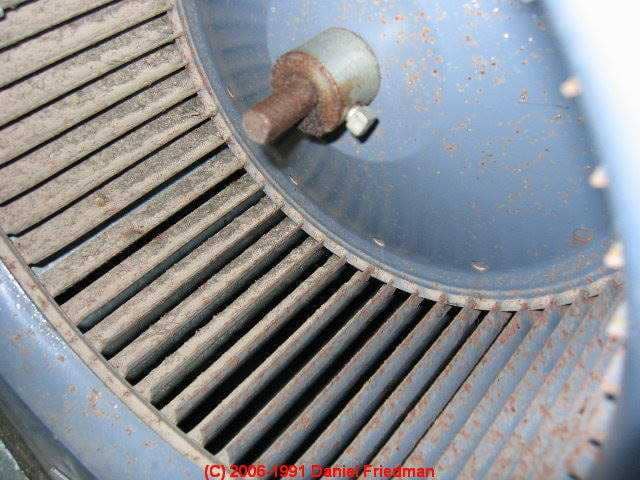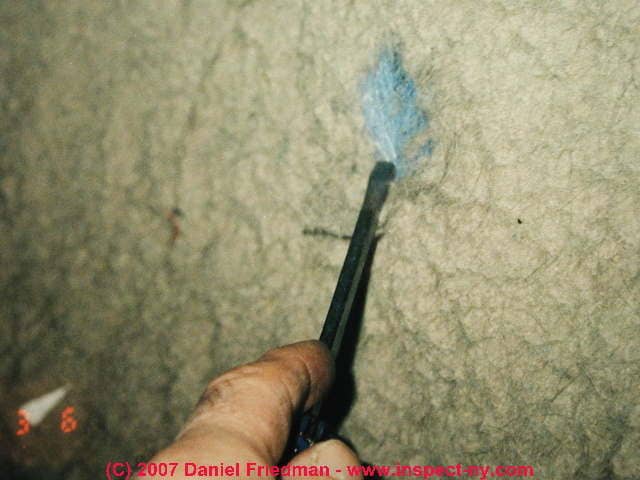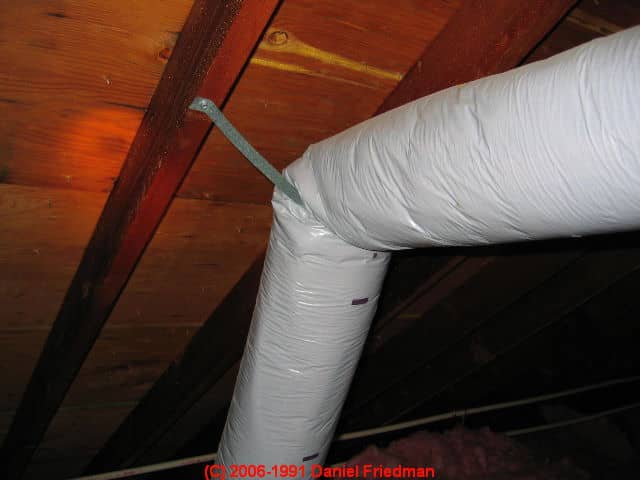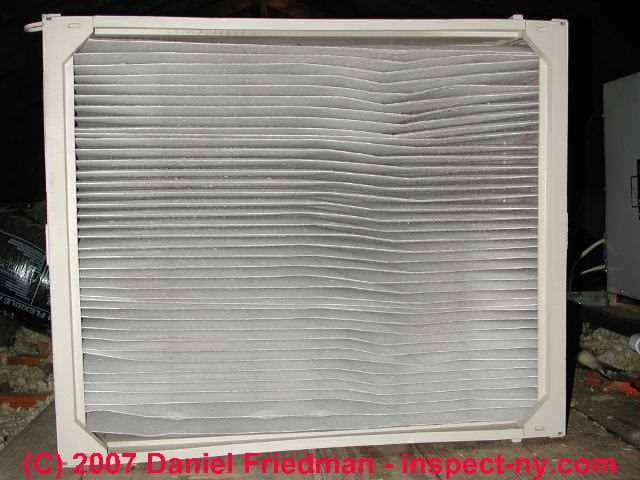 Cascaded & Optimal Air Filters for IAQ
Cascaded & Optimal Air Filters for IAQ
- POST a QUESTION or COMMENT about how to optimize the effectiveness of indoor HVAC system air filtration by air filter selection, design, installation, maintenance
How to optimize indoor air filtration: this article explains how to select and install air filters on heating and air conditioning systems to obtain the best indoor air quality by superior air filtration.
We describe the design of a cascade or series of air filter types and how they are placed to provide very high levels of indoor dust or airborne particle removal.
Naturally if there is an IAQ problem source in the building it is essential to also find and correct that condition. In these articles we are referring to filters installed on central air conditioning or central heating systems that move air through air handlers and duct systems. Standalone or portable "air cleaners" are generally ineffective in buildings and are not capable of removing an indoor air quality problem.
InspectAPedia tolerates no conflicts of interest. We have no relationship with advertisers, products, or services discussed at this website.
- Daniel Friedman, Publisher/Editor/Author - See WHO ARE WE?
Optimum Indoor Air Filters: Air Filter Choices & Placement for Optimum Indoor Air Quality
 This website article series almost any question you might ask about air filters for heating or air conditioning systems.
We explain how an air conditioning service technician will diagnose
certain common air conditioning system failures or defects.
This website article series almost any question you might ask about air filters for heating or air conditioning systems.
We explain how an air conditioning service technician will diagnose
certain common air conditioning system failures or defects.
We include photographs to assist readers in recognizing cooling system defects.
Readers should also see AIR FILTER CLEANER EFFECTIVENESS and Real-World Effectiveness of Air Cleaners
in our INDOOR AIR QUALITY IMPROVEMENT GUIDE article series.
Selecting Air Conditioning System Filter Types & Air Conditioner Filter Cascading for Optimum Indoor Air Quality and maximum reduction in airborne particles involves selection of high efficiency filters and other filtration equipment and placing them in the correct order and in the most effective location within the air conditioning system air handler and duct work.
Article Contents
- HVAC CASCADED AIR FILTER EFFICIENCY
- CASCADED AIR FILTER DESIGNS
- ELECTRONIC vs ELETROSTATIC AIR CLEANERS
- HEPA or high MERV air filter
- UV DISINFECTION in HVAC SYSTEMS
- PHOTO CATALYTIC - PCO AIR CLEANERS
- EFFECTIVENESS of CASCADED AIR FILTERS
- HOW TO USE a CASCADED AIR FILTER
- AIR FLOW LOSS by CASCADED AIR FILTERS
...
Air conditioning and heating system filter efficiency
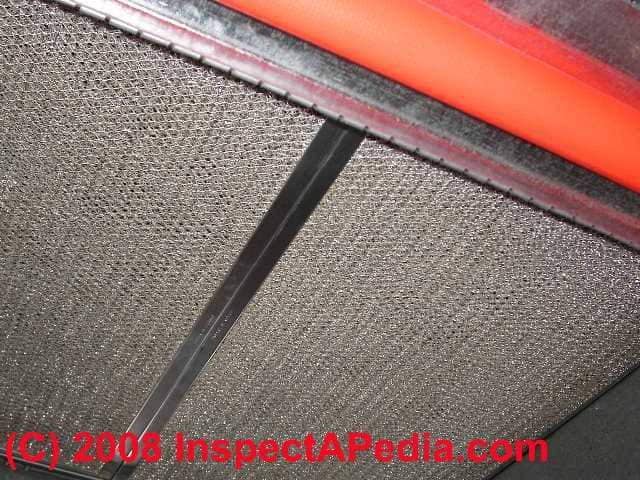 Highly efficient air conditioning or heating air handler or duct air filters which trap smaller particles are available, right down to HEPA filters.
We recommend improved filtration installed particularly
in buildings where occupants have mold, allergy, or other respiratory concerns.
Highly efficient air conditioning or heating air handler or duct air filters which trap smaller particles are available, right down to HEPA filters.
We recommend improved filtration installed particularly
in buildings where occupants have mold, allergy, or other respiratory concerns.
For the front-end air filter described in the cascaded air filter system outlined below, we selected a Filtrete Filter - the Micro Allergen 1000TM reduction filter made by the 3M Corporation. This filter is described as also resisting microbial growth.
- Washable air filters
such as the stainless steel mesh air filter that came with our air handler are the least efficient at capturing airborne dust particle, with a relative efficiency of roughly 1/20th that of the Micro Allergen 1000TM air filter. - Non-electrostatic pleated air filters
have a relative efficiency of about 1/20th that of the Micro Allergen 1000TM air filter. - Non-electrostatic mini pleated air filters
have a relative efficiency of about 50% that of the Micro Allergen 1000TM air filter. - The 3M Micro Allergen 1000TM
reduction filter and air filters of similar rating made by many other air filter manufacturers has a performance rating of 1000 by 3M and a MERV of 11 with an air-flow rate of 1.5 meters per second. This filter is rated as capturing 80% of airborne dust particles in the 3 to 10 micron size range (ASHRAE particle class E3).
This is more than adequate to capture most typical indoor allergen and mold particles, but will be less efficient at capturing the smallest mold spores such as Penicillium sp. and Aspergillus sp. which can produce some spores in the 1-2 micron size range. - The 3M Filtrete Ultra Allergen 1250TM
reduction filter is rated by 3M at 1250.
Air filter effectiveness and MERV ratings are described in detail
...
Cascaded Air Filter Designs: Optimum Air Filtering Can be Obtained by Air Filter Selection, a Combination of Air Filters, & Air Filter Placement
At our forensic microscopy lab where it is important to keep the dust and airborne debris to a minimum, when we replaced our heating/cooling system we specified the following filters in the order shown, moving from the building air return to the air handler itself.
Cascades of filters will significantly reduce airborne particulate debris, mold, pet allergens, dust mite allergens, and similar particles.
But as we discuss below, cascaded air filters may also cause an unwanted reduction in total air flow unless the heater or air conditioner blower fan is of adequate capacity.
It may be possible to regain some of this lost air flow by making sure that the blower assembly is clean and that the duct system is not leaky or blocked anywhere.
The use of a variable speed fan with high output capacity combined with a discussion with our installer provided a heating system that was able to provide excellent air filtration without suffering from airflow restriction or air starvation.
We discuss the detection of duct system defects such as blockages and leaks at DUCT SYSTEM DEFECTS.
Below we describe a series of filters that might be placed in a cascaded HVAC air filter design, in the order of installation beginning at the front-end at the air return.
1. First cascaded air filter: the Front End Filter
Front end air filter: shown at left and represented by arrow #1 in the photo above, at the central air return we installed a typical inexpensive 1" disposable filter which protects the return ducts from high levels of debris.
This filter is changed monthly. Our first photo just above in this article shows the installation of a front-end filter at the return air register in our lab.
Our photo above left shows the first stage of a cascaded air filter system: here we've installed a filter right at the return air register.
A dirty filter is shown at lower left and the new clean filter has been set in place.
If your HVAC system has only one air filter, the best location for it is at the return air inlet register such as shown in this picture. This protects the entire duct system and air handler from accumulating unwanted dust and debris.
Often we see that the only filter on an air conditioning or warm air heating system is installed right at the air handler, perhaps at the blower inlet.
The disadvantage of this filter location is that the entire return duct system can serve as a collector for dust and allergens, becoming a potential reservoir for growing mold colonies, especially if the duct system is exposed to high moisture or water leaks.
Effectiveness of the front-end air filter:
In our experience, the front-end air filter has been doing a great job of keeping the dirt and debris level very low in our air handler, as you can see in our photo where we've removed the filter to show the interior of the sheet metal return air plenum chamber after three years of system operation.
Installing a good air filter at the return register not only keeps the return duct system itself clean, reducing future duct cleaning costs, it also reduces the workload for the electrostatic air cleaner (so we have to wash it less often), and further reduces the rate of particle clogging on our HEPA air filter installed after the electrostatic air cleaner.
Cleaning of the electrostatic air cleaner elements may be performed less frequently, perhaps annually, and replacement of the HEPA filter has been necessary only every two or three years with this cascaded filter installation.
2. Second cascaded filter: a washable metal air filter in the HVAC Return Air Plenum
Washable metal air filter:
shown at left, and arrow #2 in our photo above, in our cascaded air filter system, the front end filter shown above is followed by
this washable metal air filter that you can just see in this photo looking "up" in the return plenum under our air handler.
This washable air filter is unnecessary in our cascaded air filter installation, but because it is very low in air restriction and because it came with the air handler, we just left it in place.
If airflow restriction had been a problem with this cascaded filter system we'd leave this air filter out of the system.
3. Third step in cascaded air filtration: the electronic or electrostatic air cleaner
 Electronic air cleaner:
Electronic air cleaner:
at the air handler return plenum [See our photograph of an electrostatic air cleaner installed at the air handler, shown here and arrow #3 in the earlier photo of the entire system]
The electronic air cleaner causes airborne particles that escaped our front end filter to plate-out and stick to the electrostatic air cleaner's blades. Periodically the electrostatic air cleaner elements are removed and washed. Some manufacturers recommend simply running the unit through the dishwasher.
Be careful not to bend the metal plates or break the wires that area exposed when you remove the electrostatic air cleaner element for cleaning.
Ozone warning: The US EPA points out that
"There is no standard measurement for the effectiveness of electronic air cleaners. While they may remove small particles, they may be ineffective in removing large particles. Electronic air cleaners can produce ozone -- a lung irritant.
The amount of ozone produced varies among models.
Electronic air cleaners may also produce ultra fine particles resulting from reaction of ozone with indoor chemicals such as those coming from household cleaning products, air fresheners, certain paints, wood flooring, or carpets.
Ultra fine particles may be linked with adverse health effects in some sensitive populations."
See OZONE HAZARDS for a discussion of electronic air cleaners, ozone for odor treatment, and ozone exposure standards and hazards.
Also, in our view the EPA comment that electronic air cleaners are not effective in removing large particles may not be a significant concern. Large airborne particles that do not find themselves trapped in an ordinary air filter settle out of the air rather quickly onto building surfaces
...
What's the Difference Between an Electronic Air Cleaner and an Electrostatic Air Cleaner?
These are two completely different products.
An electrostatic air filter relies solely on the air-filter media and does not take any electrical power.
In comparison, an electronic air cleaner (such as the unit we show above) relies on electricity to perform its function by placing a positive electrical charge on wires over which air (and dust particles pass, and a negative charge on collecting plates that collect those particles.
This distinction is important when choosing an air cleaning method, as people who run heat pumps or air conditioning units should never use an electrostatic air filter due to the reduced air flow. It's a much better idea to use an electronic air cleaner on those systems. - Stephen Stanczyk, Safe Haven Inspections in Kapowsin WA
...
4. HEPA or high MERV air filter alone or in a Cascaded Air Duct Filtration System
Effectiveness of a HEPA or high MERV air filter: how about at the air handler return plenum, after the electrostatic air cleaner?
This arrangement permits
us to use the more costly HEPA filter for many months before it needs to be changed out. [Arrow #4 in the photo of the entire system shown earlier on this page]
See our photograph of a HEPA filter in the air handler (photo at left) where the filter has been removed from its housing for display purposes.
at AIR FILTER EFFICIENCY we discuss high MERV and HEPA air filters and we compare their effectiveness. Do not rush to install a HEPA filter on your HVAC system without reviewing its blower fan capacity
This is the last filter station in a super high-efficiency HVAC system air filtration approach that we used in our forensic laboratory in Poughkeepsie, New York.
But there are additional steps and air or air handler and duct treatment options that are used in some HVAC systems, with mixed and arguable effectiveness.
We discuss these next.
...
UV Light Disinfection of HVAC Ducts & Air Handlers
 UV light treatment in the duct system or air handler: is also available for HVAC systems and may be slightly helpful for areas where occupants are at extreme medical risk.
UV light treatment in the duct system or air handler: is also available for HVAC systems and may be slightly helpful for areas where occupants are at extreme medical risk.
OPINION: I have not see nenough supporting data to be convinced that these lights have much effect on air flowing past them as the contact time for
particles moving in the duct system will be minimal.Surfaces onto which the light shinges may be disinfected but not air passing by.
Most air duct installers place these UV lights in the return or supply plenum on the hypothesis that
they are disinfecting the surfaces there.
This is an appealing argument except that nothing is disinfecting the other 99% of the surface area
of the duct system. I did not install this equipment at our forensic lab.
EPA's comment on UV treatment of HVAC systems: "There is no standard measurement for the effectiveness of UVGI cleaners. Typical UVGI cleaners used in homes have limited effectiveness in killing bacteria and molds.
Effective destruction of some viruses and most mold and bacterial spores usually requires much higher UV exposure than is provided in a typical home unit.
Furthermore, dead mold spores can still produce allergic reactions, so UVGI cleaners may not be effective in reducing allergy and asthma symptoms."
Using UV light in a wide range of applications including the control of bacteria, mold, and algae or moss growth is also discussed at
...
Effectiveness of photo-catalytic air cleaners - PCO air cleaners
An evaluation of the effectiveness of photo-catalytic air cleaners - PCO air cleaners, or photo-catalytic oxidation air purifiers, use an internal cascade of filters and treatment including a front-end particle filter, a HEPA filter, a gas absorption media (such as activated charcoal).
The photo-catalytic oxidation process is achieved using a high-intensity UV light bulb combined with a titanium dioxide catalyst. Exposed to UV light the titanium dioxide becomes highly reactive and breaks down other toxic molecules (in the incoming gas contamination in building air) into other (less harmful) compounds.
Advertisements for PCO cleaners contrast their photo-catalytic oxidation process with other toxic gas absorption media such as activated carbon, zeolite, or potassium permanganate (also used in water softeners), which may re-release their gases back into building air.
Photo-catalytic oxidation, the manufacturers assert, converts toxic gas molecules into CO2 and Water. (We wonder how many possibly unanticipated organic and other gas compound molecules can all be converted to these two simple compounds.)
A final step in PCO air cleaner systems produces negative ions and "activated oxygen" - readers should see our warnings at OZONE HAZARDS. On some PCO air cleaners this feature can be turned off.
EPA's comment on PCO cleaners: "There is no standard measurement for the effectiveness of PCO cleaners.
The use of PCO cleaners in homes is limited because currently available catalysts are ineffective in destroying gaseous pollutants from indoor air. Some PCO cleaners fail to destroy pollutants completely and instead produce new indoor pollutants that may cause irritation of the eyes, throat, and nose."
Evaluation of the effectiveness of special filters for removing airborne gases
from HVAC duct systems: gas-phase filters are available for inclusion in duct systems in buildings where gas contaminants are a special problem, but gas phase air filters are much less commonly used in homes than particle air filters.
EPA points out that "the useful lifetime of gas-phase filters can be short because the filter material can quickly become overloaded and may need to be replaced often. There is also concern that, when full, these filters may release trapped pollutants back into the air.
Finally, a properly designed and built gas-phase filtration system would be unlikely to fit in a typical home HVAC system or portable air cleaner."
We also installed an automatic two-speed blower fan in the air handler.
The technician selected this blower fan as one capable of providing adequate CFM of air flow in the system with the cascade of filters we describe above.
...
Effectiveness of the Cascaded Air Filter System in the Air Ducts and Air Handler
Measuring the airborne particle level before and after installing the cascaded filter system we describe here, and obtaining actual counts of airborne dust particles per cubic meter of air, we found at least an order of magnitude reduction in the dust level in the building. When we compared before and after airborne particle counts, airborne particles in the 1-20 micron range were reduced by about 70%.
Visual inspection of horizontal surfaces on which dust accumulates showed that dust accumulated at a much slower rate than before we installed the new filter system. The actual dust level reduction that you can expect in a building where these improvements are made depends on these factors (and probably others that some readers may be kind enough to suggest):
- the initial dust level in the building
- the sources of building dust, mold, pollen, mite fecals, or other allergens, and steps that are taken to remove and prevent recurrence of these sources
- the efficiency of the air filters installed
- air duct and air handler or blower fan maintenance, including changing the front-end air filter on a regular schedule, keeping the duct system clean, etc.
- percentage of time that the HVAC blower system is in operation (more hours on means greater reduction in building dust levels)
...
How to use a Cascaded or other Air Filter System on an HVAC System
Select a blower fan capable of continuous duty and with enough power to overcome resistance of the air filters.
For maximum IAQ improvement in buildings: for the new blower installation
in our forensic microscopy lab we selected a fan unit which had both the capability of delivering adequate CFM of air flow and a blower fan motor duty cycle which
permits continuous operation if we wish to run the system that way.
Make certain that the blower fan itself is completely clean.
Dust or debris collecting on the blades of a squirrel cage blower fan assembly can cut the airflow by 50% or more.
Even if it costs a few hundred dollars to clean a dirty blower fan, the increased air flow can more than earn this cost back in increased air flow and thus reduced heating or cooling costs.
Run the air conditioning or heating system blower fan continuously
or on regular timed cycles. Running the blower continuously at low speed resulted in continual
air scrubbing in the building. When the heating or cooling needs of the building require, the fan shifts automatically to high speed.
Change the front end air filter regularly
to avoid passing dust and debris into the air handler and the downstream filters."
Because air filters restrict air flow more as they become dirty, 3M recommends (no surprise) that where air flow reduction is a concern, consumers should simply replace the air filter more often.
Remove any unnecessary air filters or duct obstructions
such as the washable metal air filter we described above.
make sure the duct system is not leaky, crimped, blocked, wet, moldy, damaged, etc.
See DUCT SYSTEM DEFECTS for details of various air duct problems and how to find and correct them.
...
Other Steps to Regain Air Flow Lost by Cascaded Air Filters or Other Duct System Problems
 In addition to the steps outlined above
In addition to the steps outlined above
at CASCADED AIR FILTER DESIGNS,
you can take maximum advantage of any air filtration system on a building's heating or air conditioning system if you install and use a blower fan which can operate continuously for maximum reduction of indoor dust levels and improved indoor air quality.
We discuss this suggestion in detail
at CONTINUOUS BLOWER FAN OPERATION.
However before installing a high-efficiency HEPA filter on your system you need to review the air flow capacity of the blower and the duty-cycle rating of the blower fan motor (can it be run continuously).
Cascades of air filters in the duct system may reduce airborne particulate debris but cascaded air filters may also cause an unwanted reduction in total air flow unless the heater or air conditioner blower fan is of adequate capacity.
It may be possible to regain some of this lost air flow by making sure that the blower assembly is clean and that the duct system is not leaky or blocked anywhere.
We discuss the detection of duct system defects such as blockages and leaks
Our photo above shows a combination or cascade of an electrostatic air cleaner combined with one or more air filters behind that silver-handled pull-out above the white air cleaner.
...
...
Continue reading at AIR FILTERS, SOURCES FOR or select a topic from the closely-related articles below, or see the complete ARTICLE INDEX.
Or see these
Allergy & Allergen Articles
- AIR CLEANER PURIFIER TYPES
- AIR FILTER CLEANER EFFECTIVENESS
- AIR FILTER EFFICIENCY Analysis of the Effectiveness of Air Filters on HVAC Systems - HEPA & MERV Ratings.
- AIR FILTER MATERIAL RE-PURPOSED for FACE MASKS
- AIR FILTER OPTIMUM INDOOR
- AIR POLLUTANTS, COMMON INDOOR
- AIR POLLUTANTS, HEALTH EFFECTS
- AIRBORNE PARTICLE SIZE DEFINITIONS & TYPES
- AIRBORNE PARTICLE SIZE TABLE
- ALLERGEN TESTS for BUILDINGS
- ALLERGY & MOLD IAQ PRODUCTS
- BIOLOGICAL POLLUTANTS
- INDOOR AIR QUALITY IMPROVEMENT GUIDE - home
- OZONE GENERATOR EFFECTIVENESS for INDOOR AIR POLLUTION
Suggested citation for this web page
AIR FILTER OPTIMUM INDOOR at InspectApedia.com - online encyclopedia of building & environmental inspection, testing, diagnosis, repair, & problem prevention advice.
Or see this
INDEX to RELATED ARTICLES: ARTICLE INDEX to BUILDING INDOOR AIR QUALITY IAQ
Or use the SEARCH BOX found below to Ask a Question or Search InspectApedia
Or see
INDEX to RELATED ARTICLES: ARTICLE INDEX to AIR CLEANERS FILTERS PURIFIERS
Or use the SEARCH BOX found below to Ask a Question or Search InspectApedia
Ask a Question or Search InspectApedia
Questions & answers or comments about how to optimize the effectiveness of indoor HVAC system air filtration by air filter selection, design, installation, maintenance.
Try the search box just below, or if you prefer, post a question or comment in the Comments box below and we will respond promptly.
Search the InspectApedia website
Note: appearance of your Comment below may be delayed: if your comment contains an image, photograph, web link, or text that looks to the software as if it might be a web link, your posting will appear after it has been approved by a moderator. Apologies for the delay.
Only one image can be added per comment but you can post as many comments, and therefore images, as you like.
You will not receive a notification when a response to your question has been posted.
Please bookmark this page to make it easy for you to check back for our response.
IF above you see "Comment Form is loading comments..." then COMMENT BOX - countable.ca / bawkbox.com IS NOT WORKING.
In any case you are welcome to send an email directly to us at InspectApedia.com at editor@inspectApedia.com
We'll reply to you directly. Please help us help you by noting, in your email, the URL of the InspectApedia page where you wanted to comment.
Citations & References
In addition to any citations in the article above, a full list is available on request.
- Wikipedia Web: https://www.wikipedia.org/ provided background information about the definition of HEPA and airborne particle interception.
- Stephen Stanczyk, Safe Haven Inspections is a professional home inspector in Kapowsin, WA 98334. Mr. Stanczyk can be reached at 253-241-0602 or by Email: steve@safehaveninspections.com
- Complete List of Air Conditioning & Heat Pump Design, Inspection, Repair Books at the InspectAPedia Bookstore.
- Modern Refrigeration and Air Conditioning, A. D. Althouse, C.H. Turnquist, A. Bracciano, Goodheart-Willcox Co., 1982
- Principles of Refrigeration, R. Warren Marsh, C. Thomas Olivo, Delmar Publishers, 1979
- In addition to citations & references found in this article, see the research citations given at the end of the related articles found at our suggested
CONTINUE READING or RECOMMENDED ARTICLES.
- Carson, Dunlop & Associates Ltd., 120 Carlton Street Suite 407, Toronto ON M5A 4K2. Tel: (416) 964-9415 1-800-268-7070 Email: info@carsondunlop.com. Alan Carson is a past president of ASHI, the American Society of Home Inspectors.
Thanks to Alan Carson and Bob Dunlop, for permission for InspectAPedia to use text excerpts from The HOME REFERENCE BOOK - the Encyclopedia of Homes and to use illustrations from The ILLUSTRATED HOME .
Carson Dunlop Associates provides extensive home inspection education and report writing material. In gratitude we provide links to tsome Carson Dunlop Associates products and services.


